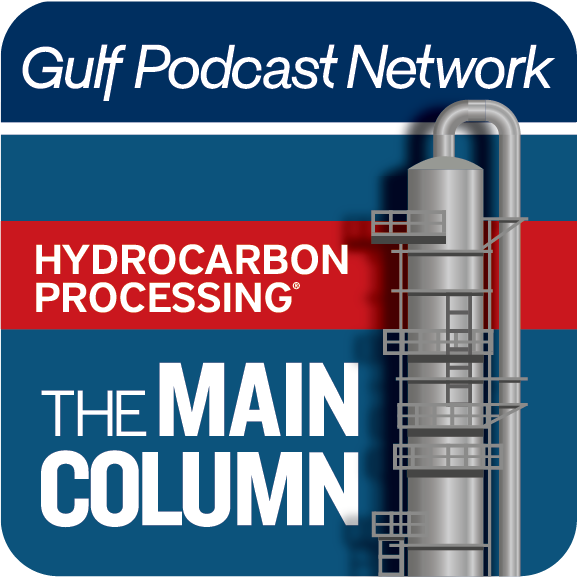At the Emerson Exchange 2025 Conference, Emerson’s Marcelo Carugo and Doug Cooper joined Hydrocarbon Processing Magazine podcast host Lee Nichols to discuss advanced digital technologies to combat corrosion.
 Visit the Gulf Podcast Network Hydrocarbon Processing “The Main Column” for the May 22, 2025, podcast recording titled Live from Emerson Exchange: Advancing digital technologies to combat corrosion.
Visit the Gulf Podcast Network Hydrocarbon Processing “The Main Column” for the May 22, 2025, podcast recording titled Live from Emerson Exchange: Advancing digital technologies to combat corrosion.
Transcript
Lee: So hello everyone. I want to welcome you all to this latest episode. My name is Lee Nichols and I’m going to be your host. Now this is a very special episode as we are live from Emerson Exchange. And today’s episode is all about corrosion.
Now to discuss this extremely important subject, which affects, I think, nearly every industry around the world, we have two very special SMEs from Emerson joining us today: Marcelo Carugo and Doug Cooper. How are you guys doing today?
Marcelo, Doug: Great. Great.
Lee: Well listen I know this conference y’all are very very busy so I really appreciate y’all’s time today. So before we dive into some of the questions I have about corrosion can you provide the listeners a little bit more information about yourself and your roles with Emerson?
Marcelo: Certainly. Thank you Lee for having us here. Very much appreciated the opportunity. Marcelo Carugo. I am Vice President for Industry Solution Consulting and Customer Success at Emerson. I’ve been with Emerson 27 years.
Doug: And I’m Doug Cooper. I am the Director of Product Management for our APM business unit within Emerson. And I’ve been with Aspen Tech slash Emerson for five years now.
Lee: Excellent. So today we’re talking all about corrosion. So my quick question to start off this conversation is can you put corrosion monitoring into context for the listeners? So in other words, how big of a problem is corrosion in refineries today?
Marcelo: Certainly. If we look at the refineries with the utilization of opportunity crudes that has been more and more pervasive on the past five, ten years we can see a larger impact of corrosion because of these different crudes and the switching of crudes. When we look at refineries we can see refineries in different parts of the world that will switch 100 crudes a year.
Maybe the largest ones would switch 300 crudes a year. And this different variety of crudes provide different complexity of mechanisms of attacks for corrosion that are different. And there is an opportunity of making more money using these crudes but also provides the challenge of how to manage the corrosion. And of course if there is a corrosion incident in a refinery in most cases it could be a safety, will produce a safety incident as well. So we want to avoid that at all costs.
Managing corrosion has always been a situation with manual inspections. Now with technology we can actually improve a lot how we can manage that and actually capture a lot of the value and profitability that the refinery can have.
Lee: Yeah, well that’s actually a great segue into my next question is so what are some of the traditional ways that refiners are managing their corrosion, and you know that then leads to where are they falling short?
Doug: Yeah, I can handle that one. So Lee, what most of the refiners have done in the past is they’ve done manual inspections using you know UT thickness or X-ray and they’ll take a corrosion measurement at a period of time, six months, a year, and then they’ll graph those out and they’ll look at the you know the corrosion rates based on you know those two points or eventually you get three, four, five points and that’s how you get your corrosion rates. But in that middle of that six months, they really don’t have any idea what’s gone on if they switched crude slates or different things in the middle. They could have had corrosion rates that are varying, so it’s very much backward-looking. I know now that this is how much wall thickness I have left, this is how much remaining useful life I have in the pipe, but I don’t know what’s gone on in between.
So Emerson has taken some steps to help out with that with our Rosemont Permasense sensors. And so with the Permasense sensors, they’re wireless sensors, they’re online, and they’re able to take corrosion measurements typically once a day. So now they have a really good idea real time of what’s going on from a corrosion standpoint and how maybe different crude slates affect that. And you know if they’ve changed some process conditions, they can start to see some of those things. But again it’s all still looking in the rearview mirror. I know it’s happening with corrosion and you know what companies are now asking for is more of how do I manage that? Is there a way to manage the corrosion? Not just you know go with what’s happening out there. So that’s what we’re looking to move forward to.
Lee: Excellent. And so then I kind of want to swing back to the topic of opportunity crudes. So y’all have a joint session here at Emerson Exchange this week and y’all are talking about leveraging the benefits of opportunity crudes. Now you mentioned, of course, it can be economically beneficial, but can you talk a little bit more about the benefits of opportunity crudes?
Marcelo: Yes, certainly. So when you process an opportunity crude, you have different areas that you can leverage the value of the molecule, right? And there is a great opportunity of processing more opportunity crudes if you can manage all the challenges that you have through corrosion and the processing. But also availability of the units is important. And for that, the integrity management of the units is really a key area. And also addressing the maintenance costs, right? So when we look at all these three aspects of the profitability of the refinery, we identify for a typical 200,000-250,000 barrel refinery, an opportunity of about $10 million.
Lee: Okay. Wow. Then let’s talk about combating corrosion. So can y’all talk a little bit more about why a new corrosion management solution is needed then to help combat corrosion?
Doug: Yeah. So what we want to do is help these operating companies understand the causes of corrosion, whether it be some of these different crude slates, process type conditions, and if they can understand when we’re starting to see the beginning of a higher corrosion rate, what’s going on, they oftentimes, you know, from a process standpoint, can make some slight corrections and put them back down into acceptable corrosion levels.
And on the flip side of things, you know, with what Marcelo talked about earlier, with the different crude slates, with some of the models we’re going to be building with this, they will have a better understanding of the corrosion rates they could see if they do decide to go down that road. And then again, we can play with some of the process conditions to help them stay in more manageable corrosion rate areas of where they want to be going forward.
Lee: Okay. Yeah. And then that kind of then leads me to my next question, because I want to talk about the solution, which I know features Emerson products and then AspenTech software. So can y’all talk a little bit more about those key features?
Marcelo: Yeah, certainly. We are leveraging on this new development, the full stack of Emerson and AspenTech. So we are tackling the instrumentation. And certainly is what Dark mentioned about the thickness sensors. But also we are looking at the data around the unit, right? So if we are talking, for example, a crude unit, we are looking at the crude data, we are looking at the lab data, we are looking at the process data. And we combine all these with machine learning and AI from AspenTech to be able to leverage the new technologies and being able to get all these new insights that you can have, right?
Because something that probably the listeners could relate to, you buy crudes nowadays and they come with a crude assay, but the properties of the crude that you have are not normally what the assay says, right? So you have to take that into consideration. And then typically the refineries will have blends of these crudes. So how that will behave and what will be the corrosion rate impact is a time concept that we have to manage there, right? And this tool provides you the ability to manage this on a day-to-day basis.
Lee: And so let’s talk real-world case studies because I know so many people in this industry say that sounds great, benefits are great, does it work? So I’m wondering if y’all have any type of examples from some initial customers who’ve already started to see the success with this solution.
Marcelo: Yes, of course. So we have been working with a selected group of customers on a pre-alpha version of the tool. And we were looking at different use cases with them. And they found value in, I would say, three different areas.
So in many cases, you have in a refinery, you have a particular corrosion incident, and you have to go back and look at what is the root cause of this. And it’s something that is time-consuming. In some cases, it could take weeks. Some worse cases could take a few months to identify that, right? And with this tool, we are able to provide you insights in what the root cause has been and what were the main contributors to that incident in minutes. Who were the main contributors to that incidence in minutes. So that’s one of the things that we found this group of refiners were able to appreciate.
The other one has been for a certain scenario, to do some scenario analysis. If we are going to run a certain crude and if we want to run it for certain operating conditions to get the more value of the molecule. What will be the envelope that we can run? What are going to be the conditions for that? So that scenario analysis has been another good value that refiners appreciated.
And finally, when you’re looking at the operating conditions from the point of view of corrosion, you have also an operating window that it will operate. But because of the different aspects we talked before, this window is not static, it’s dynamic. So this tool also provides you what is the dynamic operating window at any time. So you can optimize from the point of view of minimizing corrosion.
Lee: Oh wow, okay. Excellent. And then it’s incredible technology. So yeah, and I know how busy you guys are, but I mean, is there any closing thoughts before we let you all go?
Doug: Yeah, we have one. So Marcelo talked about pre-alpha, but we’re getting ready to have an alpha where we’re doing some testing. And we would love to have the input of operating companies. We’ve put our heads together and we think we’ve got what is gonna be a great solution, but we greatly value the voice of the customer, right? And we’d love to have them participate in this.
So we are actually gonna be kicking off some alpha testing of this new solution. And we’d love to have input and have loved to participate. So if anyone would like to participate, they can reach out to Marcelo or myself. Marcelo’s email is [email protected] and I’m [email protected]. And we’ll get you able to be signed up and participate and provide some feedback and help us shape how this tool is gonna take shape.
Lee: Excellent. We’ll put y’all’s email address in the show notes.
Marcelo: Perfect. Thank you very much, Lee.
Lee: Excellent. Well, listen, I know how busy y’all are at this event. It’s a huge event. I’ve learned actually a lot already and I think it’s only been about a day and a half. So it’s been really good. So again, really want to thank y’all for carving out a couple minutes to talk to us about this important topic. And of course, as always, we want to thank all of you for listening to this very special episode live from Emerson Exchange.
-End of transcript-

